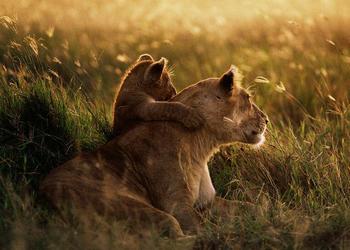
WASHINGTON, DC, October 27, 2014 (ENS) – The U.S. Fish and Wildlife Service today proposed listing the African lion as threatened under the Endangered Species Act, saying its analysis finds the lions are “in danger of extinction in the foreseeable future.”
The three main threats facing the African lion, Panthera leo, at this time are habitat loss, loss of prey animals, and increased human-lion conflict.
“Sport-hunting was not found to be a threat to the species at this time,” the Service said in a statement announcing the proposal.
Still, the Service is also proposing a rule under the Endangered Species Act that would establish a permitting mechanism for the importation of sport-hunted lion trophies, provided that the lions originate from countries with a scientifically sound management plan for the species.
Conservation groups say a strong permitting system is critical because the U.S. imports over half of the hundreds of lion trophies brought home by trophy hunters globally each year.
African lions are still found across a large range in Africa, but about 70 percent of the current African lion population exists in only 10 major strongholds, the Service said
“The African lion – a symbol of majesty, courage and strength – faces serious threats to its long-term survival. Listing it as a threatened species will bring the full protections of U.S. law to lion conservation, allowing us to strengthen enforcement and monitoring of imports and international trade,” said Fish and Wildlife Service Director Dan Ashe.
“It is up to all of us, not just the people of Africa, to ensure that healthy, wild populations continue to roam the savannah for generations to come,” said Ashe.
“By providing incentives through the permitting process to countries and individuals who are actively contributing to lion conservation, the Service will be able to leverage a greater level of conservation than may otherwise be available,” said Ashe.
The authoritative Red List of Threatened Species maintained by the International Union for the Conservation of Nature, IUCN, lists the African lion as Vulnerable, with a population trend that is “declining.” Click here to see the listing.
The U.S. Endangered Species Act benefits foreign species by prohibiting or regulating their import, export, commercial activity, interstate commerce and foreign commerce.
The Act can generate conservation benefits such as increased awareness of listed species, research efforts, funding for in-situ conservation of the species in its range countries, and limited funding for programs to conserve listed species in foreign countries, including personnel and training.
In 2011, a petition from a coalition of organizations requesting the Service to list the African lion as endangered prompted a formal review under the Act. On November 27, 2012, the Service published a positive 90-day finding and initiated a status review of the subspecies.
In today’s 12-month finding on the petition, the Service determined that listing the African lion as threatened throughout its entire range is warranted.
The petition was submitted by Born Free USA, Defenders of Wildlife, the Fund for Animals, Humane Society International, The Humane Society of the United States and the International Fund for Animal Welfare.
“Lion numbers have declined by more than half in the last three decades. To allow trophy hunting to continue unabated is kicking an animal while it’s already down,” said Jeff Flocken, North American regional director, International Fund for Animal Welfare. “We thank the U.S. government for acknowledging that this iconic species is in grave trouble and that unsustainable trophy hunting is a part of this problem.”
In the past three decades, the number of African lions in the wild has dropped by more than 50 percent, with potentially fewer than 32,000 remaining today, the conservation groups warn.
A recent study found that the West African lion population is critically imperiled with roughly 400 lions in total found in only four protected areas (down from 21 in 2005).
The most current estimates state that there are an estimated 2,000 lions left in Central Africa; 18,000 in East Africa and 11,000 in Southern Africa.
“Lion populations and the habitat available to them have diminished dramatically in recent years due to trophy hunting, bone trade, meat and organ consumption, disease, and agricultural expansion,” commented Adam Roberts, chief executive of Born Free USA. “Born Free and our partners on the ground in Africa will keep vigilant watch on lions and lion trade to ensure that the government’s decision today enhances conservation. The lion has no margin for error.”
“A threatened species listing for African lions will help ensure that American trophy hunters stop contributing to the decline of African lions,” said Teresa Telecky, director of Humane Society International’s Wildlife Department.
“While we are disappointed that the U.S. government appears poised to continue allowing the import of some lion trophies, it’s vital that protective trophy import standards be put in place and that there will be transparency in that process. American hunters import about 400 trophies of wild lions each year, so we hope that the ESA protection will significantly curtail this destructive activity.”
The Service is seeking comments from the public for 90 days regarding information pertaining to the African lion. Go to www.regulations.gov Docket No. FWS-R9-ES-2012-0025 for additional information. The proposed rule will publish in the Federal Register on October 29, 2014, comments must be received by January 27, 2015.
© 2014 – 2020, Environment News Service. All rights reserved. Content may be quoted only with proper attribution and a direct link to the original article. Full reproduction is prohibited.
